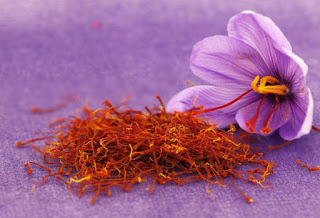SAFFRON AND GLAUCOMA
Introduction
Abnormal resistance to the
outflow of aqueous humor through the trabecular meshwork (TM) is a key factor
in the pathogenesis of primary open angle glaucoma (POAG).
Oxidative stress plays a role in
the development of POAG by causing changes in the TM.
Saffron is derived from the
pistils of Crocus sativus.
It contains high concentration of
crocin and crocetin (carotenoid derivatives).
Saffron is a powerful radical
scavenging, antioxidant and antitumor agent.
In a study performed in Iran, it
has been shown that high doses of oral saffron extract can reduce intra-ocular
pressure (IOP).
The saffron study
The above mentioned study was
performed at the 22nd of Bahman Hospital, Gonabad, Iran.
Inclusion criteria were set as:
Patients with POAG older than 50 years of age being treated with timolol 0.5%
BD and Dorzolamide 2% TID, judged to have stable glaucoma control for atleast 6
months, based on a series of visual field and optic nerve head examinations.
34 patients were randomized to
receive either saffron extract or placebo.
The study was kept double blinded
from patients, ophthalmologists and statisticians.
Crocus sativus stigmas were
collected from Gonabad. Using the maceration technique saffron capsules
containing 30 mg of concentrated powder was prepared. Starch powder capsules
were used for placebo.
Subjects were randomly assigned
to oral saffron (30mg per day) or oral starch capsules for one month, while
continuing the topical medications.
At the end of the study all
patients entered a one month washout period when saffron was stopped while
continuing the topical medications.
Results: Mean baseline IOP was 12.9+/- 3.7 (7-19) mmHg in
the saffron group and 14+/-2.5 (9-18) mmHg in the control group.
One week after intervention, IOP
was 12+/-3.3 mmHg in saffron group vs. 13.6+/-2.6 mmHg in the control group. At
four weeks IOP was 10.6+/-3 (6-16) mmHg in saffron group vs. 13.8+/-2.2 mmHg in
control group. At the end of the washout period IOP was 12.9+/-3 (8-18) mmHg in
saffron group and 14.2+/-2.0 in the control group.
Discussion
Antioxidants are beneficial in
reducing the risk of multiple ocular diseases including AMD.
Oxidative stress is also
implicated in the development and progression of POAG.
The trabecular meshwork is
especially sensitive to oxidative stress.
Light-induced formation of
oxidative radicals may target the TM and contribute to the pathogenesis of
glaucoma.
Disturbed cell homeostasis from
oxidative stress may lead to cellular loss and structural alterations in it's
extracellular matrix, resulting in impaired aqueous humor outflow and thereby
an increase in IOP.
Saffron has the ability to reduce
IOP, but it may also have antioxidant-neuroprotective properties.
Antioxidants exert a short term
effect by rehabilitating damaged but still functional TM, and a long-term
benefit by reducing apoptosis.
The ocular hypotensive effect
shown by saffron extract can be attributed to short term effect.
Safety
Saffron has low toxicity and
doses upto 1.5gm are regarded as safe.
The colored constituents of
saffron may accumulate in sclera, skin and other tissues to mimic icteric
features.
Nausea, vomiting, diarrhea is
reported in doses around 1.5-2gm.
Conclusion
Saffron may prove to be a safe
and effective hypotensive agent with additional antioxidant-neuroprotective properties.









No comments:
Post a Comment